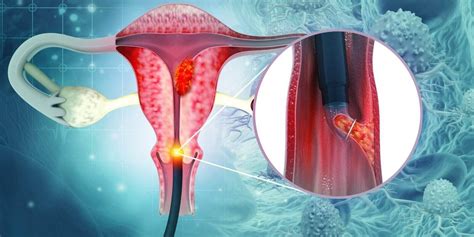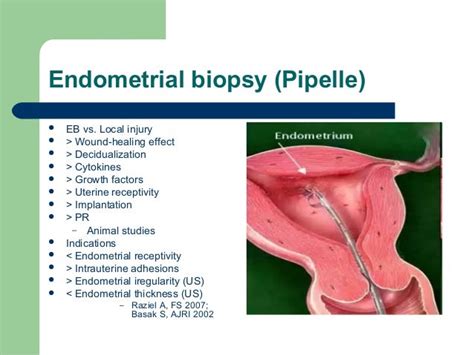Intro
Learn about the Uterine Lining Biopsy Procedure, a diagnostic test for endometrial cancer, involving tissue sampling and histological examination to detect abnormalities, irregular bleeding, and infertility issues.
The uterine lining biopsy procedure is a diagnostic tool used to investigate abnormal uterine bleeding, infertility, and other reproductive health issues. This procedure involves removing a small sample of tissue from the lining of the uterus, known as the endometrium, for examination under a microscope. The uterine lining biopsy is a relatively simple and quick procedure that can provide valuable information about the health of the uterus and help diagnose various conditions.
Abnormal uterine bleeding is a common symptom that affects many women, and it can be caused by a variety of factors, including hormonal imbalances, uterine fibroids, and cancer. In some cases, abnormal bleeding can be a sign of an underlying condition that requires medical attention. The uterine lining biopsy procedure can help diagnose the cause of abnormal bleeding and provide valuable information about the health of the uterus. Additionally, the procedure can be used to investigate infertility, as certain conditions that affect the uterine lining can make it difficult for a woman to become pregnant.
The uterine lining biopsy procedure is typically performed in a doctor's office or clinic, and it usually takes about 10-15 minutes to complete. The procedure is relatively painless, although some women may experience mild cramping or discomfort during the procedure. The doctor will use a speculum to hold the cervix open and a thin, flexible tube called a catheter to collect a sample of tissue from the uterine lining. The sample is then sent to a laboratory for examination under a microscope. The results of the biopsy can provide valuable information about the health of the uterus and help diagnose various conditions, such as endometrial cancer, uterine fibroids, and hormonal imbalances.
Benefits of Uterine Lining Biopsy

Some of the benefits of the uterine lining biopsy procedure include:
- Providing a definitive diagnosis of various conditions that affect the uterus
- Helping to identify the cause of abnormal uterine bleeding
- Investigating infertility and identifying conditions that may be affecting fertility
- Being a relatively quick and painless procedure
- Providing valuable information about the health of the uterus
How the Procedure is Performed
The uterine lining biopsy procedure is typically performed in a doctor's office or clinic. The procedure usually takes about 10-15 minutes to complete, and it is relatively painless. The doctor will use a speculum to hold the cervix open and a thin, flexible tube called a catheter to collect a sample of tissue from the uterine lining. The sample is then sent to a laboratory for examination under a microscope.The steps involved in the uterine lining biopsy procedure include:
- The doctor will insert a speculum into the vagina to hold the cervix open.
- A thin, flexible tube called a catheter is inserted through the cervix and into the uterus.
- The catheter is used to collect a sample of tissue from the uterine lining.
- The sample is then sent to a laboratory for examination under a microscope.
- The results of the biopsy can provide valuable information about the health of the uterus and help diagnose various conditions.
Risks and Complications

It is essential to discuss the potential risks and complications with a doctor before undergoing the uterine lining biopsy procedure. The doctor can provide more information about the potential risks and complications and help determine if the procedure is right for each individual.
Preparation and Aftercare
To prepare for the uterine lining biopsy procedure, it is essential to follow the doctor's instructions carefully. Some of the things to keep in mind include: * Scheduling the procedure during a time when bleeding is light or absent * Avoiding sexual intercourse and douching for at least 24 hours before the procedure * Taking a pain reliever, such as ibuprofen, before the procedure to help reduce discomfort * Bringing a friend or family member to drive home after the procedureAfter the procedure, it is essential to follow the doctor's instructions carefully to ensure proper healing and minimize the risk of complications. Some of the things to keep in mind include:
- Resting for at least 24 hours after the procedure
- Avoiding heavy lifting, bending, or strenuous activities for at least 24 hours after the procedure
- Avoiding sexual intercourse and douching for at least 24 hours after the procedure
- Taking a pain reliever, such as ibuprofen, as directed to help reduce discomfort
Results and Follow-up

Once the results are available, the doctor will discuss them with the patient and provide a diagnosis and treatment plan. Some of the potential results of the uterine lining biopsy include:
- Normal: The uterine lining is normal, and no abnormal cells or conditions are present.
- Abnormal: The uterine lining is abnormal, and further testing or treatment may be necessary.
- Cancer: The uterine lining contains cancer cells, and further testing and treatment will be necessary.
It is essential to follow up with the doctor after the procedure to discuss the results and determine the next steps. The doctor can provide more information about the results and help determine the best course of treatment.
FAQs
What is a uterine lining biopsy?
+A uterine lining biopsy is a diagnostic procedure that involves removing a small sample of tissue from the lining of the uterus, known as the endometrium, for examination under a microscope.
Why is a uterine lining biopsy performed?
+A uterine lining biopsy is performed to investigate abnormal uterine bleeding, infertility, and other reproductive health issues.
What are the risks and complications of a uterine lining biopsy?
+The risks and complications of a uterine lining biopsy include infection, bleeding, cramping, and damage to the uterus.
We hope this article has provided you with a comprehensive understanding of the uterine lining biopsy procedure. If you have any further questions or concerns, please do not hesitate to comment below or share this article with others who may find it helpful. Additionally, if you are experiencing any symptoms or concerns related to your reproductive health, we encourage you to consult with a healthcare professional for personalized advice and care. By taking an active role in your health and well-being, you can help ensure that you receive the best possible care and treatment.
